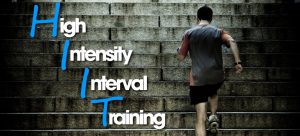 If you’ve never heard of HIIT—High Intensity Interval Training—you haven’t read much on working out. It’s one of the hottest ways of maximizing your workout time. It involves a rotation between giving any type of exercise a 100 percent effort followed by a period of recovery for an equal or longer time. If you’re a runner, you’d run at top speed for a minute and then jog for one or two and back to top speed again. Not only is this great for achieving cardio fitness faster, since it gets the heart pumping at top speed, but it also helps burn fat fast.
If you’ve never heard of HIIT—High Intensity Interval Training—you haven’t read much on working out. It’s one of the hottest ways of maximizing your workout time. It involves a rotation between giving any type of exercise a 100 percent effort followed by a period of recovery for an equal or longer time. If you’re a runner, you’d run at top speed for a minute and then jog for one or two and back to top speed again. Not only is this great for achieving cardio fitness faster, since it gets the heart pumping at top speed, but it also helps burn fat fast.
HIIT does the job faster.
You won’t have to workout as long to get the same results. Studies on the HIIT exercise technique show that the results for middle-aged and young healthy individuals were better than other types of endurance training for improving the amount of oxygen brought into the body. It also helped reduce the risk of type II diabetes and improved muscle endurance in record time. While traditional cardio workouts using HIIT may not be great for weight loss, non-traditional ones are.
Circuit training is a combination of strength training and HIIT.
The original HIIT exercises were aimed at running and cardio, but that shouldn’t limit the uses of it. Consider circuit training as a whole body workout. You’re trying to get as many muscles worked in as short of time frame as possible, with a little rest in between. Unlike HIIT, which works to exhaust total energy in a short period, then rest for an equal or longer period, circuit training works one muscle group hard, then allows a quick breather between exercises and works another group of muscles, giving the first rest. It’s more of a total body workout.
The benefit of varying muscle groups and intensity.
By doing both, you’ll not only build muscle strength and endurance, you’ll boost your metabolic rate, too. It provides an afterburn of calories for up to 48 hours after the workout ends. The EPOC—excess post-exercise oxygen consumption occurs after a hard workout to counter-act the deficit of the workout. This deficit occurs with both types of training, so it boosts your metabolic while trying to normalize the body and eliminate the oxygen debt.
You can convert any type of exercise to HIIT training. You don’t have to run or jog. Lifting heavy weights rapidly and then doing the same exercise with lighter weights at a normal pace gives both cardio and strength training.
Do a short version of circuit training using HIIT. Kettlebells work well for this. Your trainer can show you some great exercises.
Why do dancers stay healthy and in shape for so long? They’re actually doing HIIT training on the dance floor. When the band starts up with a fast-paced song, the intensity begins. After two to three minutes, the band stops, allowing the dancer to rest a bit before the next intense session.
Want a HIIT routine you can do at the beach or pool. Swim laps and then rest a bit. Remember, Michael Phelps ate 12,000 calories a day to maintain weight, so it must burn calories.
